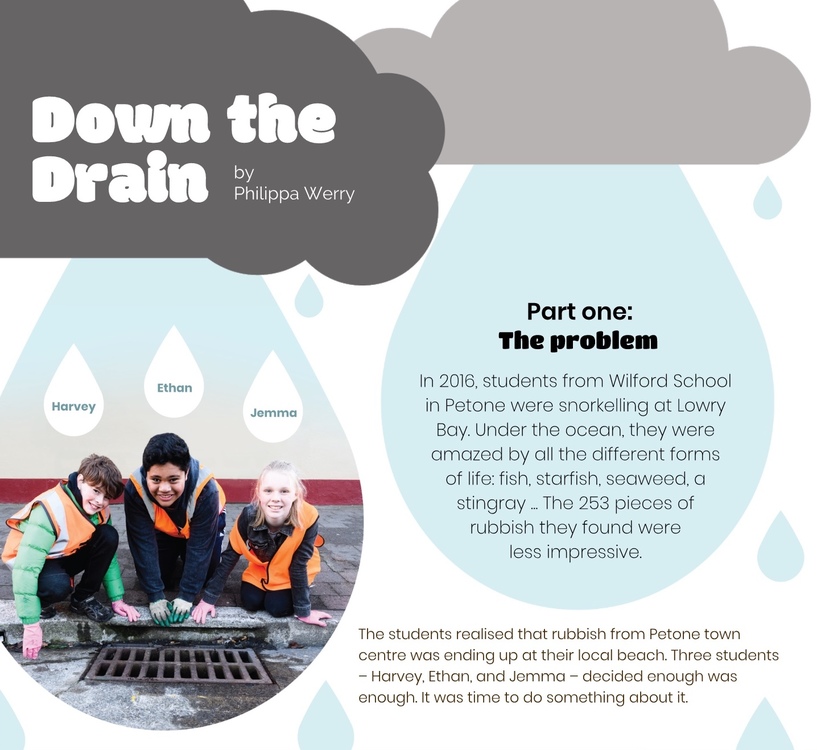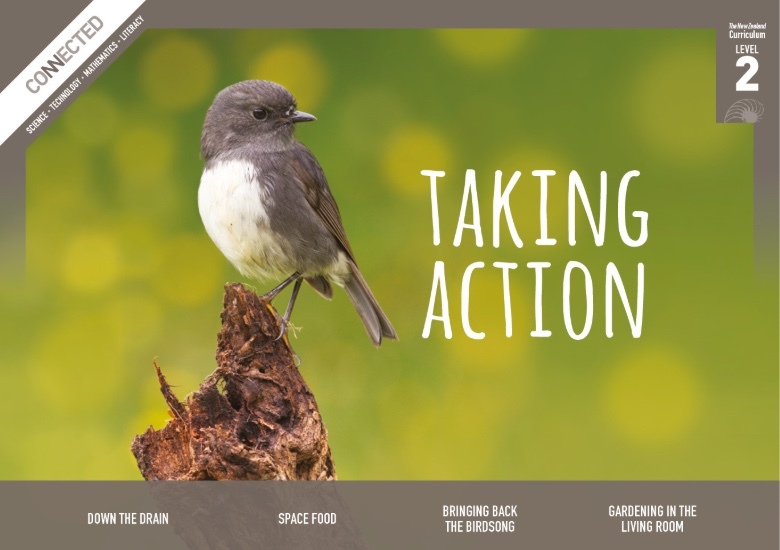Students from Wilford School in Petone, Lower Hutt, found more than they expected when snorkelling in Lowry Bay. They decided to investigate the connection between rubbish and stormwater drains.
Over a 12-week period, the students used LittaTraps to monitor the rubbish entering two stormwater drains on Jackson Street – Petone’s main street. The students emptied the traps each week and inventoried what they found. Using maths skills, they estimated that over half a million pieces of rubbish potentially enter into Lowry Bay each year from Jackson Street alone! The students shared their information with the community, and as a result, the local council donated plaques to remind people that the stormwater drains to the sea.
Supporting the science capability ‘Interpret representations’
This Connected article uses diagrams and tables to clearly explain:
- the origins of stormwater in urban and rural settings and where the water goes
- the differences between wastewater and stormwater
- how a LittaTrap works
- the different types of rubbish that end up in the ocean and how long it takes to break down
- the mathematical steps students used to estimate how much rubbish moves from Jackson Street to the ocean each year.
Discussing the components of these diagrams supports students’ development of the science capability ‘Interpret representations’.
Teacher support material
The teacher support material (TSM) for this article identifies the key science and nature of science (NoS) ideas featured in the article. The notes provide explicit NoS links to sections of text. The three learning activities are a mix of investigation and taking action for change, which supports the science capability ‘Engage with science’.
Check your school resource area for the article from the 2017 level 2 Connected journal, ‘Taking action’, download it as a Google slide presentation from Tāhūrangi or order it from the Ministry of Education.
The TSM (Word and PDF files) and reusable content (text and images) can be downloaded from Tāhūrangi. Look for the icons below the article abstract.
Related content
Plastic is a wicked problem. It’s incredibly useful, but it’s also a huge environmental issue. A helpful resource is Thinking about plastic – planning pathways which includes our interactive planning pathway – use this to begin a cross-curricular look at plastics.
Check out our entire range of Connected articles here. We’ve curated them by topic and concepts.
Activity ideas
The article Oceans of rubbish reports on an extensive 10-year seafloor survey. Included in the article is the image Human litter in marine habitats. A section of this image shows a beer can at a depth of 950 m. Start a discussion and provide context by using an online map to find a location 950 m from the classroom. Consider how the can arrived at this depth and, using information from ‘Down the drain’, how long the can might remain in this isolated location.
The activity What happens to our plastic bottles? uses the New Zealand Ready to Read books At the Beach and What Does the Tide Bring In? to introduce the PET plastic recycling process.
Constructing an aquifer model is a simple visual demonstration of the pathway of rainwater through the soil and/or over the land.
Citizen science
The Litterati and Litter Intelligence are two citizen science projects that ask people to photograph, geotag and classify litter. The Backyard Battle and Mizuiku Upstream Battle projects, run by Keep New Zealand Beautiful, aim to collect and audit litter to help provide a better understanding of the pathways and root causes of pollution.
Backyard Battle and Mizuiku Upstream Battle are two citizen science projects run by Keep New Zealand Beautiful. The aim is to collect and audit litter to help provide a better understanding of the pathways and root causes of pollution in Aotearoa.
See this case study for an example of how a similar project was used with students in year 2–4.
Project Hotspot is a citizen science project to protect coastal species in the Taranaki region – see the types of rubbish Taranaki students found in their marine environment.
Useful links
The Connected journals can be ordered from the Down the Back of the Chair website. Access to these resources is restricted to Ministry-approved education providers. To find out if you are eligible for a login or if you have forgotten your login details, contact their customer services team on 0800 660 662 or email orders@thechair.education.govt.nz.
The science capabilities have been identified by the Ministry of Education as contributing to a functional knowledge of science and support the curriculum’s Nature of Science strand.
Visit the Enviropod website to learn more about the LittaTrap, which is available for purchase in New Zealand. Use an online search to find a supplier.
In this Stuff news article met students Jemma Allwood, Harvey Butler and Ethan Neru and their teacher Ailsa Webb to find out more about this project.
Acknowledgement
The Connected series is published annually by the Ministry of Education, New Zealand.


